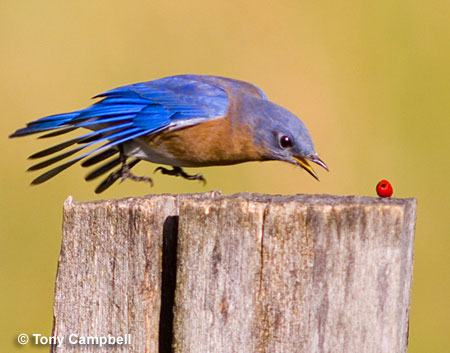The Eastern Bluebird (Sialia sialis) is a small, bright blue and peach-colored thrush. Females aren’t as colorful but still show lovely blue highlights on their wings and tail.
Eastern Bluebirds occur in parts of southeastern Canada and much of the eastern USA.
They also live in montane regions in Mexico and northern Central America.
In its range, this pretty bird is common in places with meadows and scattered trees. In summer, they usually occur in pairs but at other times of the year, small flocks visit orchards and other places with fruiting trees.
On this page
Identification
The Eastern Bluebird is a small thrush with a white belly and dark, peach-orange throat, breast, and flanks. That same peach-orange color also extends onto each side of their neck. On average, they are 7 inches long, have a 13 inch wingspan, and weigh around 1.1 ounces.
Males have beautiful, deep sky-blue upperparts. Females are grayer above but have blue highlights in their wings and tail, and more white on their throat.
Female Eastern Bluebirds also have prominent “broken” eyerings that are wider in back of their eyes. Both sexes are similar in size although females tend to weigh more, at least in the breeding season.
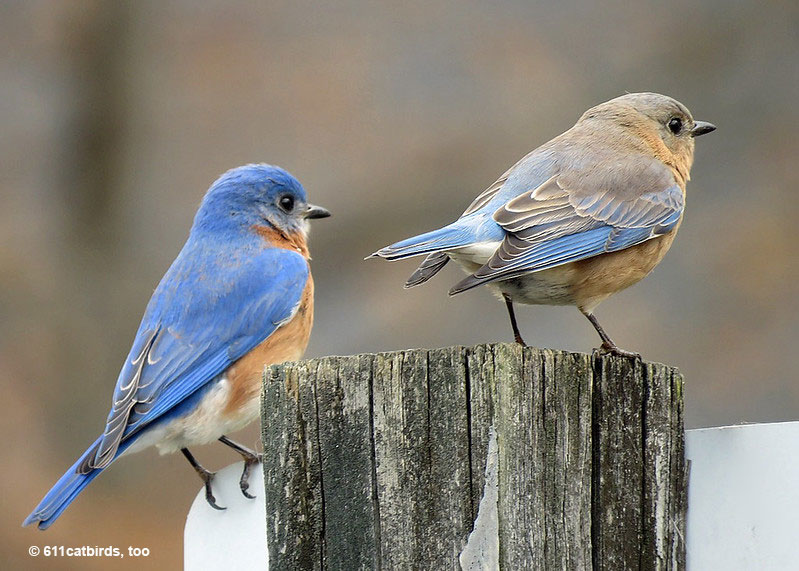
Male Eastern Bluebird is on the left, female on the right.
Males and females also have a fairly short black beak with some pale coloration on its base, and fairly long, blackish legs.
The Eastern Bluebird has long, pointed wings with some black edging on their blue feathers. Those black highlights are particularly notable on their wing tips.
Juvenile Eastern Bluebirds resemble females but have heavily spotted underparts. Their eyerings are also more prominent.
This species is easy to recognize. In most of its range, the Eastern Bluebird is the only bird species with blue upperparts and orange coloration on its throat or breast.
Both sexes make pleasant “feew” calls, and the male sings a brief, warbling song, “fhip a rip weep a fip“.
Food
The Eastern Bluebird mostly feeds on insects and spiders that live on or near the ground. They catch a lot of grasshoppers and crickets along with beetles, caterpillars, cicadas, and other insects.
Occasionally, this species also catches other small creatures, even small salamanders and snakes!
In fall and winter, Eastern Bluebirds also feed on small fruits.
The Eastern Bluebird forages for insects by waiting on a perch in a meadow or other open, grassy habitat. When it spots an insect or other potential prey, the bird flies low over the ground, lands, and quickly snatches the arthropod with its beak.
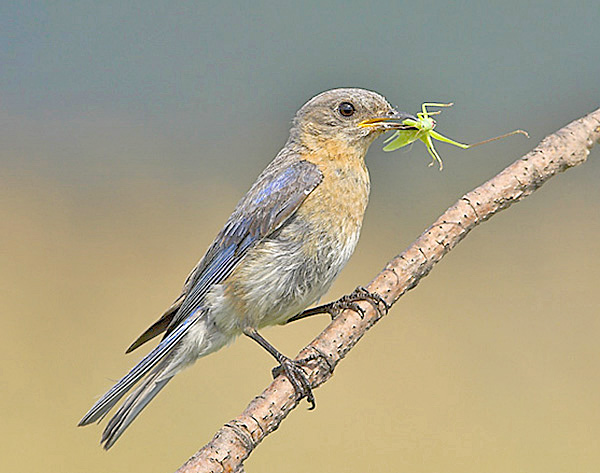
Female. Photograph © Glenn Bartley.
It has excellent eyesight and can spot a small insect in the grass more than 100 feet away!
It does most of its foraging in the morning and later afternoon. Later in the summer, this species also picks insects from vegetation and occasionally hovers low over the ground before flying down to catch its food.
Before they learn how to hunt from a perch, juveniles forage by hopping along and picking up bugs off the ground.
In winter, flocks move around in search of fruiting trees. They can visit orchards and also feed on mistletoe, sumac, and other types of small berries.
Nesting and Eggs
Eastern Bluebirds nest in tree cavities and nest boxes. The female gathers nesting materials from the ground to make a loose cup nest out of grass and pine needles. She often lines the nest with fine grass but can also use horse hair and feathers.
Nests in natural tree cavities are in dead pines or oaks and are usually in abandoned woodpecker holes. They can also nest in crevices made fires in Longleaf Pines.
Natural cavity nests can be 50 feet above the ground, but they can also nest much lower. Most next boxes are around five feet above the ground.
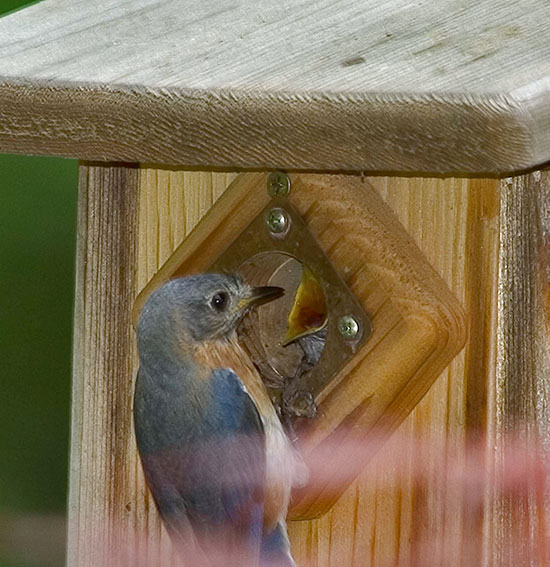
Eastern Bluebirds will use a tree cavity or next box in all sorts of open and semi-open situations, but they prefer spots with short grass and a nearby perch. They won’t nest in dense forests. They can also use old nests and sometimes seem to prefer to do that.
The female Eastern Bluebird lays five, pale blue or blue-green eggs that are .18 long and weigh .12 ounces. She incubates them for around 14 days. After hatching, both parents feed the nestlings and they stay in the nest for 17 to 21 days.
Fledgling bluebirds hide in cover near the nest for seven to ten days but can fly and forage on their own two weeks after leaving the nest.
Current Situation
The Eastern Bluebird lives in open areas with short grass and scattered perches. We find this beautiful bird in places like golf courses, open meadows, and farm fields.
They won’t live in dense forest but will use many places that combine short grass, perches, and nesting cavities. To avoid predation by American Kestrels, they tend not to nest under power lines or other high perches used by that small raptor.
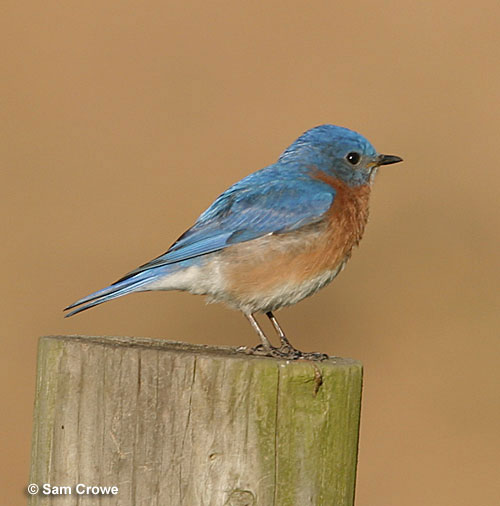
The Eastern Bluebird lives east of the Rocky Mountains in parts of southern Canada and most of the eastern USA. It also lives in montane forests from southeastern Arizona to Nicaragua.
Eastern Bluebirds declined in the past but have recovered and are listed as Least Concern in the IUCN Red List.
Although Eastern Bluebirds can be affected by pesticides, fire ants, and competition for nest sites with starlings and House Sparrows, “bluebird trail” nesting boxes have helped them in many areas.
Facts
- The Eastern Bluebird is the state bird for Missouri and New York. This species lends a beautiful summer touch to meadows and other open grassy habitats in both of these states.
- Male Eastern Bluebirds attract a mate by finding a good nesting hole, bringing nesting material to it, and then waving their wings as they perch above it.
- Before people used nest boxes to help Eastern Bluebirds, they were being replaced in many areas by introduced House Sparrows and European Starlings. These more aggressive species were kicking bluebirds out of their nests and using most available tree cavities.
- There are three bluebird species. In western states and provinces, the Eastern Bluebird is replaced by the Mountain Bluebird and the Western Bluebird.
- The Grandala is the bluebird’s closest relative. This glowing, sapphire-blue bird lives in high elevations in the Himalayas and China. It looks somewhat like a bluebird, has a similar shape, and has some similar behaviors.
Similar Species
The Eastern Bluebird is unique in much of its range. However, it does look a bit like the other two species of bluebirds and can be occasionally found with them.
Western Bluebird
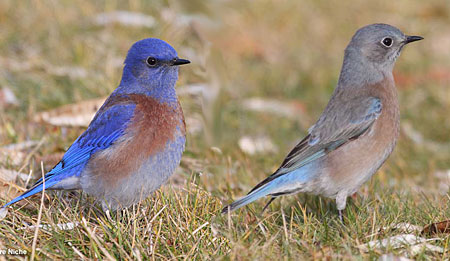
The Western Bluebird is plumaged a lot like the Eastern Bluebird but is darker blue, has a gray belly, a chestnut back, and has either blue or dark gray on its throat. As the name hints, they are common in the western side of the U.S.
Mountain Bluebird
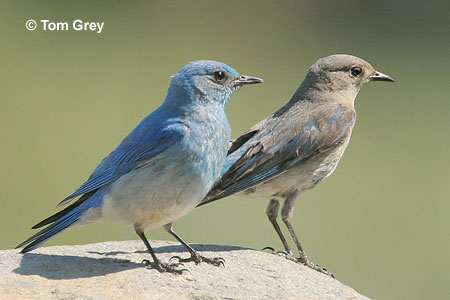
Another western bird, the Mountain Bluebird, is a paler, sky-blue bird with no orange in its plumage. The female also lacks orange and is more uniform gray than the female Eastern Bluebird.
Frequently Asked Questions
Are Eastern Bluebirds rare?
No, Eastern Bluebirds are common in many areas. They are not endangered and have benefited from the installation of bluebird nesting boxes.
Where does the Eastern Bluebird usually live?
The Eastern Bluebird usually lives in open habitats with short grass and scattered perches. They like meadows, farm fields, and similar situations in southern Canada and much of the eastern USA.
Are Eastern Bluebirds friendly to humans?
Yes, Eastern Bluebirds are friendly to humans. Although they might not let you get too close to them, they don’t bother people or their pets and can use nesting boxes near people.
Why are Eastern Bluebirds good to have around your property?
Eastern Bluebirds are good to have around your property because they act as natural pest control. They eat a lot of insects, have a pleasant warbling song, and beautiful blue plumage.
Do Eastern Bluebirds mate for life?
Yes, Eastern Bluebirds mate for life. The same pair will stay together for nesting, year after year. However, if a nest fails, they may “divorce” and find new mates.

